

Cape Dory Typhoon
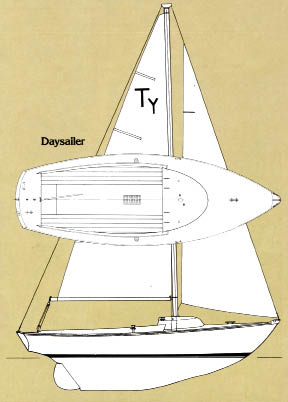
First impressions The Typhoon has handsome lines. The sweeping sheer accentuates a perky bow with a fine entry and trails into a soft reverse transom revealing serious overhangs. The LOA is 18 feet, 6 inches and the LWL is just 13 feet, 11 inches. Go ahead, calculate the hull speed based on the LWL. I told you the Typhoon was not a sport boat, but it's a better performer than the numbers suggest. There were three different Typhoon models, the Weekender, the Daysailer with a cuddy cabin, and an open daysailer. Late in the production Cape Dory added a 22-foot, 6-inch Typhoon Senior but not many were built. Most Typhoons, in fact about 90 percent, were Weekenders. These can be identified by the small coachroof with a single bronze port on each side and by their 3/4-fractional rig. Weekenders also included a compact interior that allowed flexible folks the option of camping out for a few days. The daysailers were masthead sloops. All models have a classic Alberg long keel hull shape with a cutaway forefoot and attached rudder. The Typhoon has some weight to it, displacing 2,000 pounds including 900 pounds of ballast. The air draft of the Weekender is 28 feet and slightly less on the daysailers.
Construction The Typhoon is a conservative design and Cape Dory followed suit with conservative-minded construction, which became a hallmark of all its later boats. The Typhoon hull is solid, hand-laid fiberglass with scantlings exceeding those found on most 25-footers. The deck is balsa cored and joined on an inward-facing flange. The fiberglass work was very well done, especially the tabbings. The hull is supported with real floors, impressive for a small boat, and the internal ballast eliminates the need for keelbolts, always a good thing on an older boat. Teak coaming boards line the cockpit and a teak toerail is another item to maintain. What to look for If you are considering a Daysailer model you should know that they don't have self-bailing cockpits. Weekenders do, however. There are plenty of items to look for in any older fiberglass boat, especially when some are 40 years old. Some specific Typhoon problems include deck crazing and cracking, especially in the cockpit and around the chainplates. Mast depression on the coachroof is solved by adding a beefed-up compression post. Portlight windows usually need to be replaced every few years. Of course, consider changing out the standing and running rigging. Also, one owner notes that the coaming boards should be replaced every 20 years. This assumes that you are going to own your Typhoon for a very long time. The Cape Dory Sailboat Owner's Association, CDSOA, www.capedory.org, is a good resource. A quaint newsletter, The Typhooner, was published by Noel Peattie until his death in 2005. The California Cape Dory Owners group has all 18 of these newsletters available online. On deck The cockpit is the heart of the Typhoon, and it's terrific. The seats are more than six feet long, and although the coamings can be a bit hard on your back, there's enough room to shift around and find a comfortable position. There are also two good-sized cockpit lockers. In fact, the Typhoon has impressive storage throughout. The tiller is well positioned at the aft end of the foot well. It doesn't take up a lot of space, you can brace yourself when heeled, and it can be tied out of the way when anchored or at the dock. The mainsheet is typically led aft to two fixed blocks on the stern deck just behind the wheel. The sheeting angle is not ideal but at least it is out of the way. I have seen Typhoons with a retrofitted traveler mounted across the cockpit seats but this clutters up the cockpit and isn't really necessary. The mast featured internal halyards that were led aft, one to each side of the aft deckhouse. This was innovative in its day. The halyards are led to cleats on the vertical backs of the deckhouse; jammers on top are nicer. The small sheet winches are usually not necessary unless flying a genoa or spinnaker. The headsail tracks are mounted on the coachroof for the jib and there's a fixed-point lead on the side deck for larger headsails. The standard boom was fitted with a small worm gear that allowed it to rotate. Do you remember roller reefing? It was a great idea that never worked very well. The concept was that the main could be reefed around the rotating boom. The problem was that it was difficult to achieve a neat wrap, especially if it was blowing, which it usually is when you need to reef. Switching to slab reefing is a good idea. Down below There isn't much down below on the Weekender, less on the Daysailer with its cuddy cabin, and nothing on the open daysailer. So let's take a quick look at the Weekender. The companionway is actually wide and easy to negotiate, just be prepared to stoop when you arrive in the cabin. There are quarterberths to either side and a V-berth forward. Once you manage to get into them, the berths are comfortable enough. There's space for a portable ice chest and small stove. Most boats have a porta potty in the cutout of the V-berth, some even came with a real marine head. Either option seems unnecessary, that's what buckets and marina bathrooms were made for. There is plenty of storage space under the berths. Lets put it this way, if it's raining the interior of a Typhoon Weekender is a lot better than a tent ashore.
Engine Although most Typhoons have outboard brackets mounted on the stern, and a handful came with inboard diesels, the question is: Why spoil the fun with an engine at all? I know, some marinas are impossible to negotiate without an engine, and if it is dead calm it's nice to fire up the outboard and steam home. A few years ago I watched a Typhoon pick up a mooring in Menemsha Harbor on Martha's Vineyard by using a long sweep mounted astern. The solo skipper calmly turned his wrist back and forth, pushing the Typhoon along decently and then reached over and plucked the pennant. If you insist on a outboard, many owners report that a six-horsepower is about the right size.
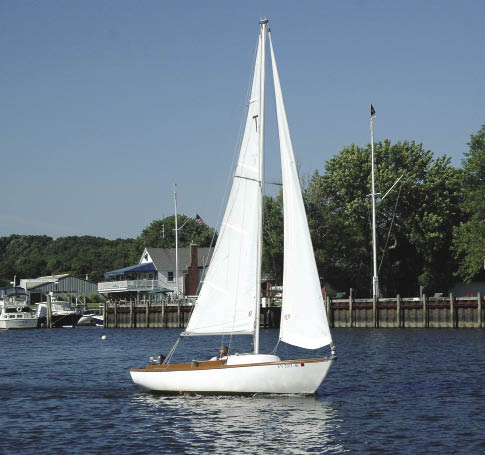
Conclusion The Cape Dory Typhoon is an enduring classic. It's handsome, nimble, affordable and downright pleasant under sail. Give me a few more years and then keep your eyes out, you'll see me puttering about the harbor one day. I'll be the guy without an engine but with a big smile.
Also in Used Boat Notebook
- Hunter Passage 42
- Pearson Rhodes 41
- Santa Cruz 52
- Allied Princess 36
- Kelly-Peterson 46
Also from John Kretschmer
- Hove to in the gales of Biscay
- Sailing's Promise
- Passage to nowhere
- Farewell to brothers of the sea
- Plotting a course to Caribbean sabbatical cruise
- Passage Planning
- Ready to Rumble
- Good vibrations
- Launching and boarding a life raft
- The Great Circle Route: Connecting the dots of a sailing life
Typhoon sr cape dory
The typhoon sr cape dory is a 22.42ft fractional sloop designed by carl alberg and built in fiberglass by cape dory yachts between 1984 and 1987., 57 units have been built..
The Typhoon sr cape dory is a heavy sailboat which is a reasonably good performer. It is very stable / stiff and has a low righting capability if capsized. It is best suited as a day-boat.
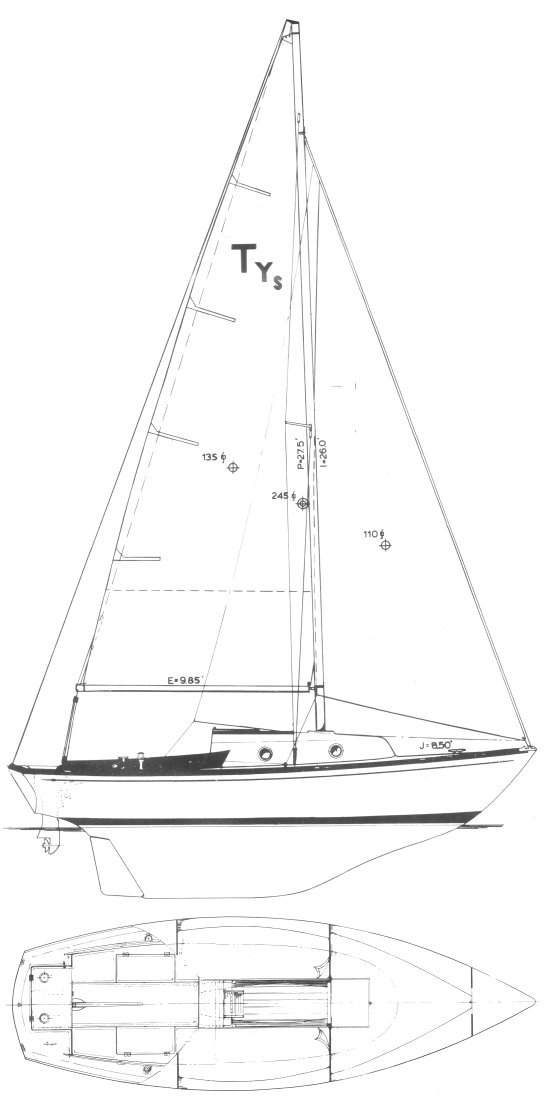
Typhoon sr cape dory for sale elsewhere on the web:

Main features
Login or register to personnalize this screen.
You will be able to pin external links of your choice.

See how Sailboatlab works in video

We help you build your own hydraulic steering system - Lecomble & Schmitt
Accommodations
Builder data, modal title.
The content of your modal.
Personalize your sailboat data sheet
- Sailboat Data
Cape Dory Typhoon Weekender Sail Data
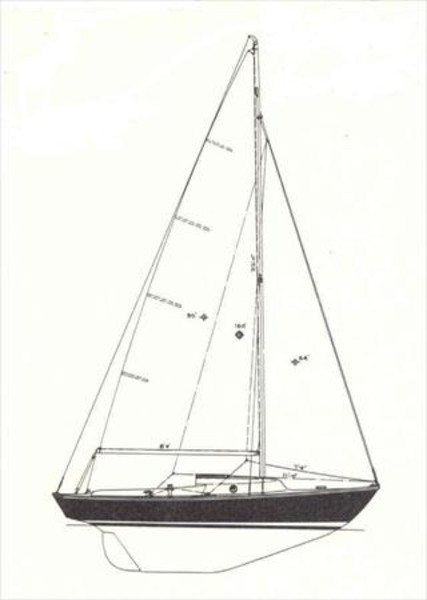
LOA 18'6" LWL 13'6" Beam 6'3.5" Draft 2'7" Displacement 2000 lbs. Ballast 900 lbs. Sail Area 160 sq. ft. Mast Height above WL 28'

Specifications TYPHOON SR (CAPE DORY)
1984 - 22.42 ft / 6.83 m - Cape Dory Yachts (USA) - Carl Alberg
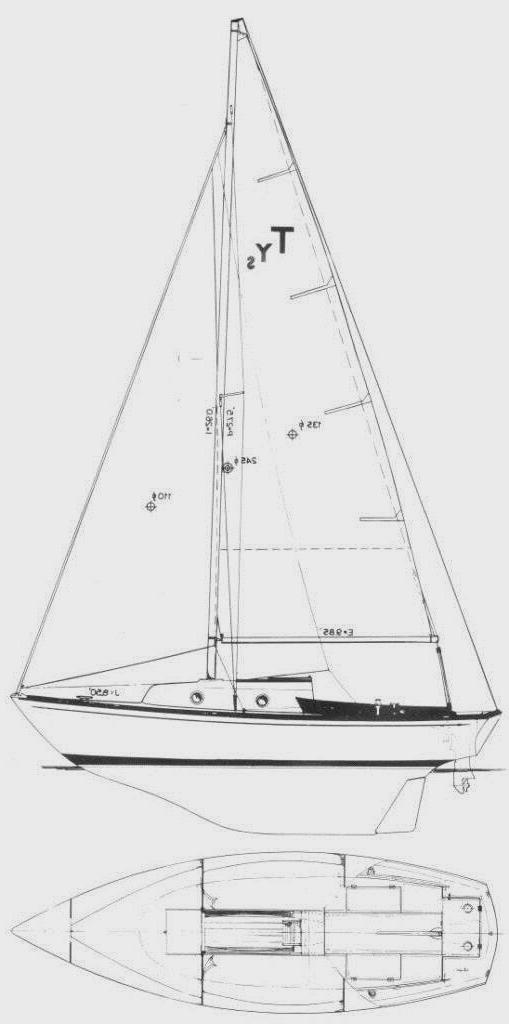
TYPHOON SR (CAPE DORY) Sailboat Data
Hull Type: Long Keel Rigging Type: Fractional Sloop LOA: 22.42 ft / 6.83 m LWL: 16.50 ft / 5.03 m S.A. (reported): 245.00 ft² / 22.76 m² Beam: 7.42 ft / 2.26 m Displacement: 3,300.00 lb / 1,497 kg Ballast: 1,700.00 lb / 771 kg Max Draft: 3.08 ft / 0.94 m Construction: FG First Built: 1984 Last Built: 1987 # Built: 57 Builder: Cape Dory Yachts (USA) Designer: Carl Alberg
Information from sailboatdata.com .
Hull Speed: 5.44 kn

Jump to navigation
Search form
- Crew Finder
- Century Club
- Start Sailing Now
- Racing Team
- See The Bay
- Boats For Sale
- Boat Reviews
- Classifieds
The Cape Dory Typhoon Used Boat Review
Posted March 27, 2017
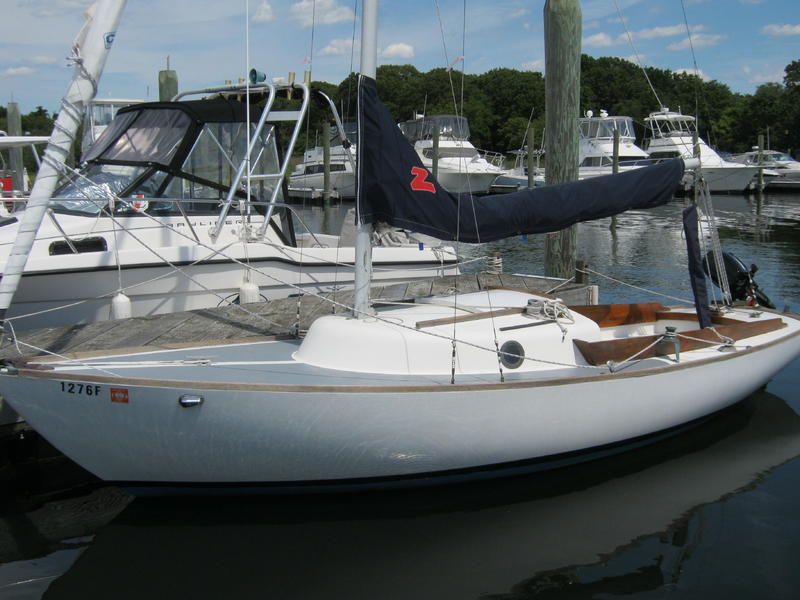
Over the years the question I’ve been asked most often as a result of these reviews is what’s the best boat for a beginning sailor or someone interested in buying his first boat. I have often avoided the question by responding that there are far too many variables to select one, two or even three best boats. Recently I’ve been thinking about this, and I’m putting together my suggestion list of the ten best starter boats. I won’t give away any final selections, but I can tell you this month’s review is on my short list.
Cape Dory Yachts introduced the Typhoon in 1967 based on a 1960 design by the late Carl Alberg. It became the cornerstone of the company’s line of conservative, sensible cruising sailboats: (many also designed by Alberg), and remained in production until 1985. More than 2,200 boats were built. The Typhoon is a full keel design with a yacht rather than dinghy like profile and seems larger than she actually is; although, dimensions are a mere 18’ 6" LOA, 13’ 11" LWL, 6’ 3" beam and 2’ 7" draft. Displacement is a healthy 1,800 to 2,000 lbs, depending on the model.
All Typhoons are solidly constructed of fiberglass cloth and polyester resin. There is a balsa wood core used in some of the deck areas and cabin top to stiffen the laminate without adding weight. There is a teak toe rail at the deck edge, fastened with stainless steel sheet metal screws, and teak combing around the cockpit. The use of teak is just enough to set off the sheer and result in a conservative, yachty appearance.
Construction is straightforward, and there is little to go wrong with Typhoons as they age that normal maintenance and upkeep won’t handle. Decks should be thoroughly checked around fittings and attachments to be certain water has not penetrated and damaged the core. The cabin top area around the mast step should be checked to see if there is any hollow or deformation. I have seen a number of Typhoons with moderate to severe problems in both these areas. Both problems are repairable, although the repairs can be quite expensive. If you fancy yourself a handyman or woman, there are a number of books available to help you get started on such projects.
Less serious annoyances with older boats include broken teak toe rails and cockpit combing, leaks at deck to hull joints, deteriorated finishes and osmotic blistering below the waterline.
The Typhoon was built as either a daysailer or weekender with slightly different deck and rig configurations. The significant visual differences are an extended cabin, the addition of a small round porthole in the cabin side, and fractional rather than masthead rig on the weekender model.
The daysailer has a large cockpit with a small enclosure beneath the foredeck for storage. The weekender features port and starboard quarter berths, a small v-berth, and space for a port-a-potty. As you might imagine, accommodations on the weekender are, to be kind, cramped and impractical, even though there were significantly more weekender models built than daysailers.
Auxiliary power can be provided by an outboard engine installed on a transom-mounted bracket. A modern 4 hp outboard engine will provide sufficient power. The drawback to transom-mounted outboard engines becomes apparent when the seas are choppy, and pitching has a tendency to raise the motor out of the water making it difficult to maintain a steady headway. When these conditions prevail, it is more comfortable and easier to maintain control under sail. It is not unusual for experienced Typhoon owners to dispense with auxiliary power altogether, although this may not be the best idea for a beginning sailor.
The working sail area of the Typhoon is about 160 sq. ft. on both models with the masthead-rigged daysailer having a slightly smaller mainsail and slightly larger jib than the fractionally rigged weekender. The sailing performance of the Typhoon is well mannered. The ideal conditions are relatively calm seas and true wind speeds from five to 12 knots. She’ll do a little better than five knots under ideal conditions, since the waterline lengthens as the boat heels.
The Typhoon’s beam is narrow, freeboard low, and it is not difficult to put the lee rail down when beating to weather in a stiff breeze. This is not only inefficient but can be quite disconcerting to beginning sailors, so reefing is advised for performance as well as comfort. Early versions of the Typhoon had a roller-reefing boom, which was replaced on later models with slab reefing. The conversion can cost several hundred dollars for hardware and sail modifications, but is well worth the expense.
With more than 2200 boats built in 16 years, finding a used Typhoon for sale is seldom difficult. A few are available with trailers but most are not. If a trailer is included, it should be inspected closely to ensure it is suitable for road use.
The Typhoon offers many features ideally suited to the beginning or novice sailor from the security of its deep comfortable cockpit to its forgiving nature. Prices are moderate and values are stable, so when you’re hooked and want to trade up in a few years, you’re not saddled with a boat that’s worth a lot less than what you paid for it. Unlike many daysailers, the Typhoons are generally kept in the water year round or at least for the sailing season. This has the disadvantage of additional cost for dockage, hauling, storage, and annual bottom painting. On the plus side, if you are considering purchase of a cruising boat, the costs are minimal with an 18’ boat and will give you a realistic feel for the true cost of boat ownership as well as your capabilities for maintaining a vessel yourself. All in all the Typhoon can be a great starter boat, but there are more than a few who have found the Typhoon all the boat they need.
Reviewed in the February 2000 issue of SpinSheet by Jack Hornor

- Privacy Policy
**NOTE: Adobe Acrobat Reader must be installed on your computer in order to download and open PDF files. If you don't have the latest version of Adobe Acrobat Reader, download it, free of charge, from Adobe's website .
Disclaimer: The CDSOA is a private voluntary social club. The CDSOA and this Web site are not associated with and do not represent Cape Dory Yachts, which is a division of Newport Shipyards Corp., nor any of the other businesses or individuals mentioned herein.
Modified by: Catherine Monaghan, Webmaster -- CDSOA, Inc.

- Forums New posts Unanswered threads Register Top Posts Email
- What's new New posts New Posts (legacy) Latest activity New media
- Media New media New comments
- Boat Info Downloads Weekly Quiz Topic FAQ 10000boatnames.com
- Classifieds Sell Your Boat Used Gear for Sale
- Parts General Marine Parts Hunter Beneteau Catalina MacGregor Oday
- Help Terms of Use Monday Mail Subscribe Monday Mail Unsubscribe
Cape Dory Typhoon
- Thread starter Terence
- Start date Aug 31, 2005
- Brand-Specific Forums
- Other Sailboats
I've recently become interested in sailing and really like the looks of the 18' Cape Dory Typhoons . . . how would owners (past or present) rate these as a learner's first boat? What mods would you recommend for single-handing, if any? CC bay is 180 square miles of protected sailing. I'd like to find something I can get out there on it in, without all the high speed acrobatics of, oh, Hobie Cats and whatnot. I'm too old to want to be that busy, lol. All replies appreciated. Thanks, T.

[email protected]
typhoon sailing a way Hi... yes you can take your typhoon sailing by your self allot of people do and if you want to learn more go to cap dory typhoon. com and learn more from others that have them over two or three hundred of them. winthrop
Tim Cropley
Typhoon on e bay It just listed , no its not mine , I just admire them too , its in Louisville Ky , but it includes a trailer and out board motor
oldragbaggers
Our first boat was a Typhoon Our first boat 25 years ago was a Cape Dory Typhoon. I was a nervous sailor at first, but I always felt secure on the little Ty. We sailed her in Hawaiian waters and we have some great memories of that boat. Despite her small size, it was not uncommon for us to have 6 people onboard. If you are considering a Typhoon, you will not regret it. Very forgiving boat.
- This site uses cookies to help personalise content, tailor your experience and to keep you logged in if you register. By continuing to use this site, you are consenting to our use of cookies. Accept Learn more…
- Print This Page
- Text Size
- Scroll To Top
Cape Dory Sailboat
Association
capedorysoa.org
Events - Future Events View
- Destination
- Virtual Meeting
- Chesapeake Fleet
- Gulf Coast/General
- Northeast Fleet
- Southeast Fleet
Great choice! Your favorites are temporarily saved for this session. Sign in to save them permanently, access them on any device, and receive relevant alerts.
- Sailboat Guide
1975 Cape Dory Typhoon
- Description
Seller's Description
This is hull #1044, a Cape Dory Typhoon sailboat that underwent a full restoration in 2018. The following Google Blogspot web address details all of the work I had done on this sailboat: cd19hull1044.blogspot.com
The boat is currently at my shop: milbsmobilemarine.com in Jacksonville, FL getting a little love and attention prior to her next owner. The sale of this popular Carl Alberg design, “America’s Littlest Yacht”, includes the following: - Fully restored (‘18) Cape Dory Typhoon sailboat - Fresh suite of sails, showing hull #1044 on the main (with reef points) - Roller Furling jib - Trailer, newly fabricated in March of this year by Sail Trailers - EPropulsion 3HP Electric Motor - Interior cushions, ground tackle (Danforth) - Trickle charger solar panel; automatic bilge pump
More on the Cape Dory can be found at the Cape Dory Owner’s Site: http://www.capedory.org/specs/typhoon.htm
Equipment: - Fully restored (‘18) Cape Dory Typhoon sailboat - Fresh suite of sails, showing hull #1044 on the main - Roller Furling jib - Trailer, newly fabricated in March of this year by Sail Trailers - EPropulsion 3HP Electric Motor - Interior cushions, ground tackle (Danforth) - Trickle charger solar panel; automatic bilge pump
Rig and Sails
Auxilary power, accomodations, calculations.
The theoretical maximum speed that a displacement hull can move efficiently through the water is determined by it's waterline length and displacement. It may be unable to reach this speed if the boat is underpowered or heavily loaded, though it may exceed this speed given enough power. Read more.
Classic hull speed formula:
Hull Speed = 1.34 x √LWL
Max Speed/Length ratio = 8.26 ÷ Displacement/Length ratio .311 Hull Speed = Max Speed/Length ratio x √LWL
Sail Area / Displacement Ratio
A measure of the power of the sails relative to the weight of the boat. The higher the number, the higher the performance, but the harder the boat will be to handle. This ratio is a "non-dimensional" value that facilitates comparisons between boats of different types and sizes. Read more.
SA/D = SA ÷ (D ÷ 64) 2/3
- SA : Sail area in square feet, derived by adding the mainsail area to 100% of the foretriangle area (the lateral area above the deck between the mast and the forestay).
- D : Displacement in pounds.
Ballast / Displacement Ratio
A measure of the stability of a boat's hull that suggests how well a monohull will stand up to its sails. The ballast displacement ratio indicates how much of the weight of a boat is placed for maximum stability against capsizing and is an indicator of stiffness and resistance to capsize.
Ballast / Displacement * 100
Displacement / Length Ratio
A measure of the weight of the boat relative to it's length at the waterline. The higher a boat’s D/L ratio, the more easily it will carry a load and the more comfortable its motion will be. The lower a boat's ratio is, the less power it takes to drive the boat to its nominal hull speed or beyond. Read more.
D/L = (D ÷ 2240) ÷ (0.01 x LWL)³
- D: Displacement of the boat in pounds.
- LWL: Waterline length in feet
Comfort Ratio
This ratio assess how quickly and abruptly a boat’s hull reacts to waves in a significant seaway, these being the elements of a boat’s motion most likely to cause seasickness. Read more.
Comfort ratio = D ÷ (.65 x (.7 LWL + .3 LOA) x Beam 1.33 )
- D: Displacement of the boat in pounds
- LOA: Length overall in feet
- Beam: Width of boat at the widest point in feet
Capsize Screening Formula
This formula attempts to indicate whether a given boat might be too wide and light to readily right itself after being overturned in extreme conditions. Read more.
CSV = Beam ÷ ³√(D / 64)
The DAYSAILER model has a slightly larger cockpit than WEEKENDER. With nearly 2000 built, this was Cape Dory’s most successful model.
This listing is presented by SailboatListings.com . Visit their website for more information or to contact the seller.
View on SailboatListings.com
Embed this page on your own website by copying and pasting this code.
Similar Sailboats For Sale

1973 Cape Dory Typhoon Weekender
- About Sailboat Guide
©2024 Sea Time Tech, LLC
This site is protected by reCAPTCHA and the Google Privacy Policy and Terms of Service apply.

COMMENTS
LENGTH: Traditionally, LOA (length over all) equaled hull length. Today, many builders use LOA to include rail overhangs, bowsprits, etc. and LOD (length on deck) for hull length. That said, LOA may still mean LOD if the builder is being honest and using accepted industry standards developed by groups like the ABYC (American Boat and Yacht Council).
Built: 141 (numbers include both the Open and Cuddy models) The Cape Dory Typhoon, "America's littlest Yacht", is one of the most popular sailboats ever built. There are more than 2,000 sailing from mountain lakes in the Rockies to the blue waters of the Atlantic, Pacific, and Carribean. The Typhoon is a joy to sail for beginner and expert alike.
The Cape Dory Typhoon Senior is a big brother to over 2,200 Carl Alberg designed "full-keel" Typhoons. The Typhoon Senior offers novice and seasoned sailors a 22-footer that is ruggedly built, easy to sail and economically priced. ... ©CDSOA and the CDSOA logo are the property of the Cape Dory Sailboat Owners Association, Inc.. Use ...
For this month's small boat issue we're taking a close look at a pint-sized classic, the Cape Dory Typhoon. Designed by the late Carl Alberg, the 18-foot, 6-inch Typhoon has been called, "America's littlest yacht." It is certainly one of America's best-loved small boats, more than 2,000 were built during a 20-year production run that ended in 1986.
Typhoon 18 (Weekender) is a 18′ 6″ / 5.6 m monohull sailboat designed by Carl Alberg and built by Cape Dory Yachts between 1967 and 1986. Great choice! Your favorites are temporarily saved for this session.
Typhoon owners across the country! The Typhoon is a sight to be remem- bered when under sail. Cape Dory Typhoon In an age when small boats are flat out racers or beamy cruisers that sacrifice performance for accommodations, the Cape Dory Typhoon stands out as "America's littlest yacht." This Carl Alberg-designed thoroughbred with
The Typhoon sr cape dory is a 22.42ft fractional sloop designed by Carl Alberg and built in fiberglass by Cape Dory Yachts between 1984 and 1987. 57 units have been built. The Typhoon sr cape dory is a heavy sailboat which is a reasonably good performer. It is very stable / stiff and has a low righting capability if capsized.
Cape Dory Typhoon SR is a 22′ 4″ / 6.8 m monohull sailboat designed by Carl Alberg and built by Cape Dory Yachts between 1984 and 1987. Great choice! Your favorites are temporarily saved for this session.
DetailsThe Cape Dory Typhoon Weekender was designed by Carl Alberg. The typhoon combines the security and stability of a full keel with an attached rudder with an easy to handle sloop rig. The deep cockpit is self bailing and over six feet long for plenty of space for friends and family. The V-berth and two quarter berths can accommodate a young family. LOA 18'6" LWL 13'6" Beam 6'3.5" Draft 2 ...
TYPHOON SR (CAPE DORY) Sailboat Data Hull Type: Long Keel Rigging Type: Fractional Sloop LOA: 22.42 ft / 6.83 m LWL: 16.50 ft / 5.03 m S.A. (reported): 245.00 ft² / 22.76 m² Beam: 7.42 ft / 2.26 m Displacement: 3,300.00 lb / 1,497 kg Ballast: 1,700.00 lb / 771…
The Typhoon Senior is an American trailerable sailboat that was designed by Carl Alberg as a cruiser and first built in 1984. [1] [2] [3] The boat is a development of the Cape Dory 22 , using the same hull mold, but a new deck and rig.
Typhoon 18 (Daysailer) is a 18′ 6″ / 5.6 m monohull sailboat designed by Carl Alberg and built by Cape Dory Yachts between 1974 and 1986. Great choice! Your favorites are temporarily saved for this session.
Cape Dory Yachts introduced the Typhoon in 1967 based on a 1960 design by the late Carl Alberg. It became the cornerstone of the company's line of conservative, sensible cruising sailboats: (many also designed by Alberg), and remained in production until 1985. More than 2,200 boats were built.
1977 - Multi-product brochure-Sailboats (PDF, 7.75 MB) -- CD10, Typhoon Daysailer, Typhoon Weekender, CD25, CD27, CD28, CD30C, CD30K 1977 - Preview brochure for the CD-36 (PDF, 1.3 MB) -- This boat was originally drawn as a ketch, but was offered as a cutter when finally introduced in 1978.
If you are currently an active member of the Cape Dory Sailboat Owners Association (CDSOA), as of 2022, you will be automatically renewed for 2023 - AT NO COST TO YOU. New Members for 2023 will be able to sign up for $25 on or about Jan 1, 2023 using the new system. If you can't wait until January, and who could blame you, this is a great group ...
Catalina 25 Essex, MD. Jan 4, 2006. #5. Our first boat was a Typhoon. Our first boat 25 years ago was a Cape Dory Typhoon. I was a nervous sailor at first, but I always felt secure on the little Ty. We sailed her in Hawaiian waters and we have some great memories of that boat. Despite her small size, it was not uncommon for us to have 6 people ...
Description. This restored 1974 classic Typhoon is pristine and won't last long. The Cape Dory Typhoon Weekender's generous exterior teak coamings and trim radiate a warmth and beauty typical to all Cape Dory yachts. The Cape Dory Typhoon, "America's littlest Yacht", is one of the most popular sailboats ever built.
10. Chessapeake / Cape Dory Sailboat Owners Rendezvous. Chesapeake Bay Maritime Museum 213 North Talbot Street St. Michaels, Maryland, 21663 410-745-2916. 8:00 AM. More Info. View. Saturday. 11. Chessapeake / Cape Dory Sailboat Owners Rendezvous.
This is hull #1044, a Cape Dory Typhoon sailboat that underwent a full restoration in 2018. The following Google Blogspot web address details all of the work I had done on this sailboat: cd19hull1044.blogspot.com. The boat is currently at my shop: milbsmobilemarine.com in Jacksonville, FL getting a little love and attention prior to her next owner.